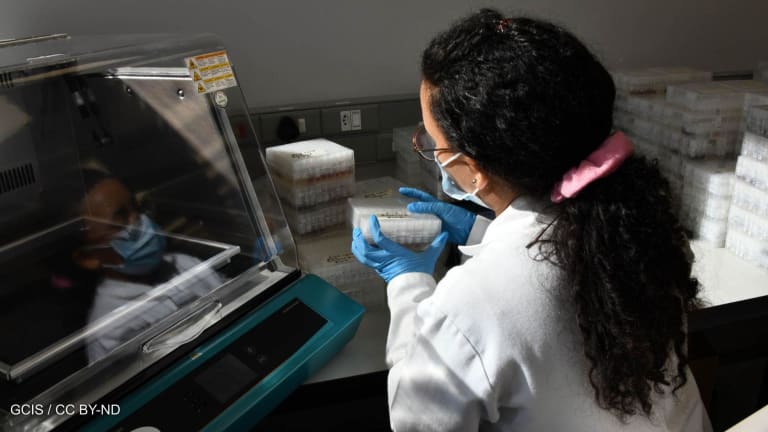
There is a 47% to 57% chance the world will experience another pandemic or epidemic that kills at least as many people as COVID-19 in the next 25 years, according to estimates from Metabiota, a San Francisco-based company that tracks infectious disease risks and outbreaks.
Metabiota applies catastrophe risk modeling — which allows financial institutions, insurers, and public agencies to understand the likelihood of extreme events and crises, such as wildfires, floods, and earthquakes — to pandemics and epidemics.
Government agencies, bilateral donors, multilateral banks, and the private sector are increasingly using its predictions to guide decision-making and budgeting. For example, Metabiota is partnering with African Risk Capacity — a specialized agency of the African Union that helps governments better plan for and respond to natural disasters — on an outbreak and epidemic insurance product that is being piloted in Guinea and Uganda.
Metabiota is not the only company focused on catastrophe risk modeling for pandemics. AIR Worldwide, for example, estimates the probability of loss from pandemics, natural disasters, cyber incidents, and more. But Metabiota is bringing a Silicon Valley approach to the field, with tools like the Pathogen Sentiment Index, a “catalog of dread” that factors in the economic consequences of public fear of a pathogen.
Metabiota models the frequency and scale of future pandemics, the potential financial losses, and the likely impact of interventions — with the goal of mitigating the worst impacts of global health threats.
How the pandemic is connecting environmental conservation and public health
There is growing recognition that it is impossible to safeguard human health without protecting natural systems. Many are calling for greater adoption of a collaborative approach called planetary health.
“A lot of our work focuses on what can we do to reduce these risks,” said Nicole Stephenson, a disease-modeling specialist at Metabiota, during a recent event hosted by the Center for Global Development. “We envision a future where the risk is much lower — hopefully — and where investments in mitigation efforts, and surveillance, and spillover reduction really reduce these risks. But based on the trends that we’re seeing right now, and based on current risks, it’s a really scary situation.”
But while COVID-19 has driven interest in Metabiota’s work, it also raises questions over how the probability of pandemics should inform preparedness, response, and financing.
Simulating what’s possible
Though the probabilities of some natural disasters, such as earthquakes, are quantifiable based on historical data, that is not the case for pandemic risk.
Pandemics and epidemics are rare and often underreported, and there is large variation in their severity, said Ben Oppenheim, vice president of product, policy, and partnerships at Metabiota.
In addition, historical data does not reflect how human activities and their impact on the environment are driving greater risk of zoonotic spillover events, in which diseases are transmitted from animals to humans.
“Computational modeling is an attempt through simulations to explore what is biologically and epidemiologically possible,” Oppenheim said. “We simulate what could happen based on what we know about coronaviruses and human populations. That gives us a full view of what could be. These are estimates that will be imprecise but hopefully useful.”
To estimate the likelihood of an event as severe as COVID-19 in the future, the Metabiota team started by compiling and analyzing a historical database of 2,600 outbreaks and epidemics since the 1918 Spanish flu pandemic. Team members saw an exponential increase in their frequency. They also conducted hundreds of thousands of simulated event catalogs that explored how these hypothetical viruses could spread around the world, accounting for changes in population, mobility, and technology over time.
They found the probability of another pandemic of the same or greater magnitude as COVID-19 to be much higher than many experts might expect: The chances are 2.5% to 3.3% in a given year, 22% to 28% in the next 10 years, and 47% to 57% in the next 25 years.
From disease surveillance to pandemic risk modeling
Metabiota was founded under a different name in 2008 by Nathan Wolfe, who is sometimes referred to as a “virus hunter.” Initially, its focus was on building disease surveillance systems, tracking where outbreaks were emerging. His original organization split into two entities, Metabiota and Global Viral, which is now the Laboratory for Research in Complex Systems.
Nita Madhav, now the CEO of Metabiota, joined the company in 2015 after a decade at AIR Worldwide. Now, half of the team of 57 people still focuses on global health security and health systems strengthening, but increasingly the company has shifted focus toward predictive analysis.
While most of Metabiota’s models were designed to understand future risks so as to mitigate them, COVID-19 has led more customers to seek real-time analysis.
“Many times when we’re building models, it’s to answer a question,” Madhav told Devex. “So the assumptions we make, how we structure it, has to do with the question we’re trying to answer. ‘How should I think about my long-term risk?’ requires a different approach than ‘what should I think about in the next three months?’”
This is not the first time Metabiota has responded to a pandemic. It was accused of making a series of mistakes in Sierra Leone during the 2014 Ebola outbreak. In response, Wolfe has said the company does not specialize in outbreak response.
“Any outbreak situation is considered a fog of war,” Madhav said, adding that criticisms about Metabiota underestimating the outbreak predated its work on pandemic risk modeling. “It’s very challenging responding on the ground. At the time, the team did the best they could. The organization is at a very different place.”
Some argue that COVID-19 has highlighted the limitations of epidemic forecasting, which is based on assumptions, with models that often fail to account for unpredictable factors, such as political decision-making around response activities.
For example, the evolution of the COVID-19 pandemic defies epidemic preparedness indexes, with countries that were supposedly prepared based on these models seeing more cases and deaths than expected, said Guillaume Lachenal, a historian of medicine at the Université Paris Diderot.
David Bell, a global health technology expert involved in PANDA, or Pandemics Data & Analytics — a group of professionals who are critical of the global COVID-19 response — also warned there is a danger of overemphasizing the risk of pandemics and neglecting other health priorities, such as malaria, tuberculosis, and HIV/AIDS, that have suffered since the outbreak of COVID-19.
Pandemic risk does not exist in isolation, and modeling efforts must take into account the range of risks that exist, including social determinants of health and disparities within countries, said Ali Mokdad, a professor of health metrics sciences at the Institute for Health Metrics and Evaluation at the University of Washington.
“There really isn’t, in the pandemic space, the kind of tool set we need to systematically monitor the risk.”
— Ben Oppenheim, vice president of product, policy, and partnerships, MetabiotaNew tool sets for the pandemic space
Metabiota is part of a larger ecosystem of organizations working on pandemic risk financing, including pandemic insurance policies, which pay out when epidemics reach certain thresholds.
Pandemic bonds have faced criticism for, among other things, failing to divert money quickly enough. The World Bank launched the Pandemic Emergency Financing Facility in 2016 but decided not to renew it in 2020.
But while there are debates as to whether pandemics are insurable, catastrophe risk modeling will be essential in forming these financial mechanisms.
As Metabiota sees growing interest in disaster risk financing, Madhav said it wants to see its data and analytic tools continue to support broader policy and decision-making. The company is piloting a new early warning system to provide notice further in advance of impending epidemics and pandemics.
After every epidemic, there are calls for investments in prevention, preparedness, surveillance, and response, Oppenheim said at the CGD event.
“There really isn’t, in the pandemic space, the kind of tool set we need to systematically monitor the risk,” he said.
The company is working with the High Level Independent Panel on Financing the Global Commons for Pandemic Preparedness and Response, which is organized by the G-20 group of nations and proposes the formation of a Global Health Threats Board in its June report.
Oppenheim said he believes the world needs an intergovernmental panel on pandemic risk, much like the Intergovernmental Panel on Climate Change.
“It [IPCC] has been able to … mobilize ‘big science’ at enormous scale to try to come up with a reasonable consensus about the nature of the risk, about the cost of human activity … and we need this kind of thinking in the pandemic space,” he added.
This coverage, presented by the Bay Area Global Health Alliance, explores the intersection between technology, innovation, and health. How are tech, innovation, and cross-sector partnerships being leveraged to accelerate equitable access to health care?









